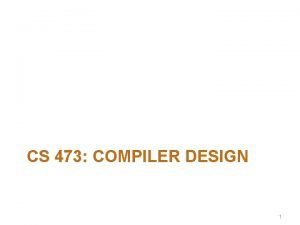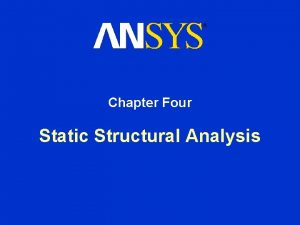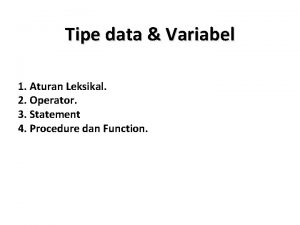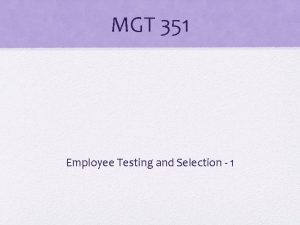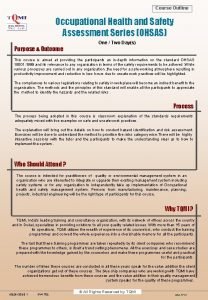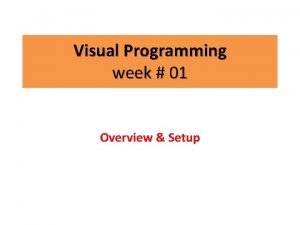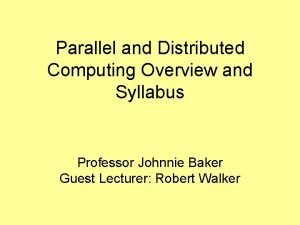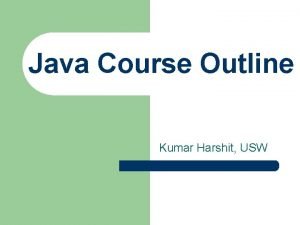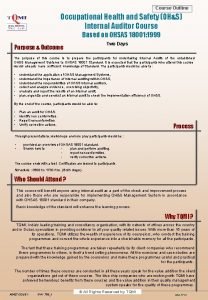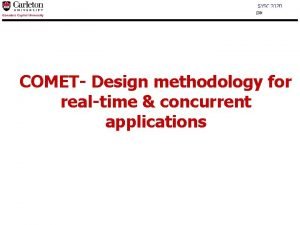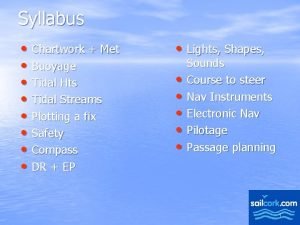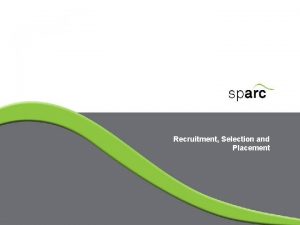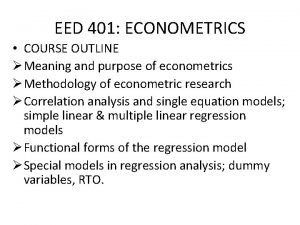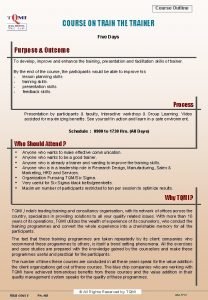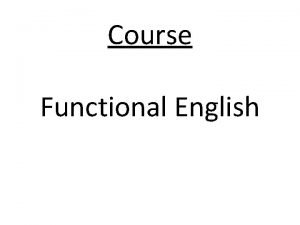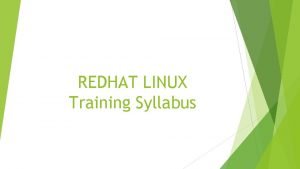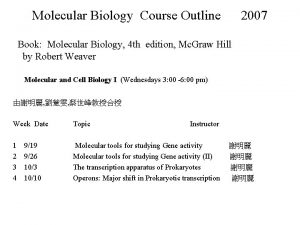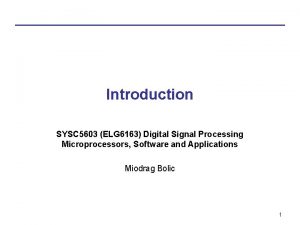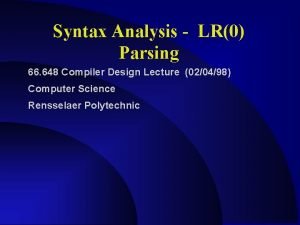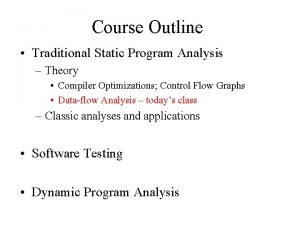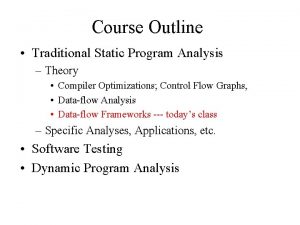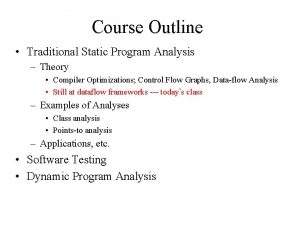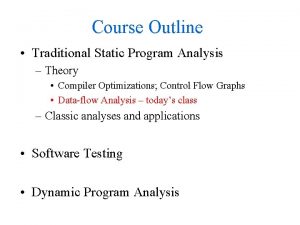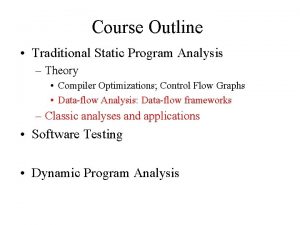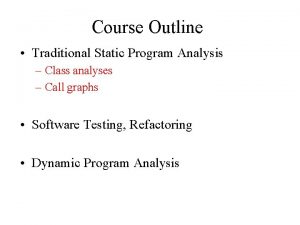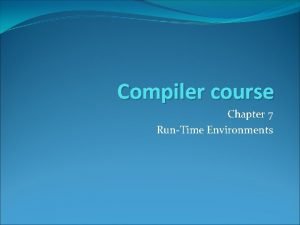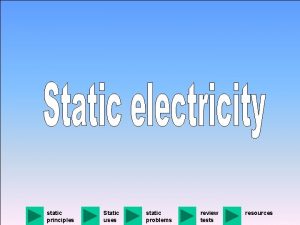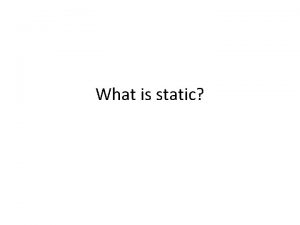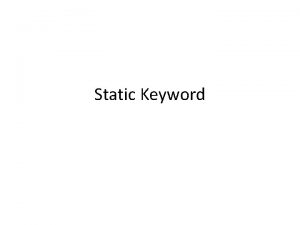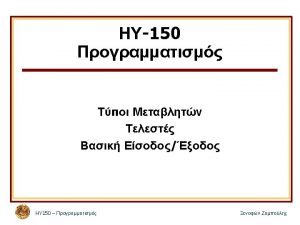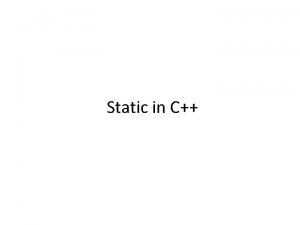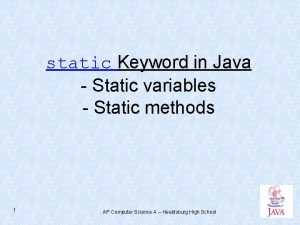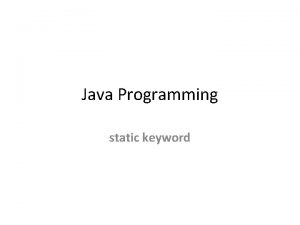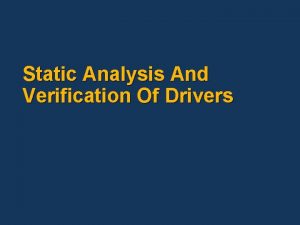Course Outline Traditional Static Program Analysis Theory Compiler








































- Slides: 40

Course Outline • Traditional Static Program Analysis – Theory • Compiler Optimizations; Control Flow Graphs • Data-flow Analysis – today’s class – Classic analyses and applications • Software Testing • Dynamic Program Analysis

Announcements • Next time: Homework 1 will be posted at: – www. cs. rpi. edu/~milanova/csci 6961/ – Due next Thursday, Feb 17 th – There will be 3 homework assignments

Outline • The four classical data-flow problems, continue – – Reaching definitions Live variables Available expressions Very busy expressions • Data-flow frameworks • Reading: Compilers: Principles, Techniques and Tools, by Aho, Lam, Sethi and Ullman, Chapter 9. 2 and 9. 3

Reaching Definitions: Example 1. x: =read() in. RD(1) = Ø 2. y: =1 in. RD(2) = out. RD (1) 3. if x<2 then in. RD(3) = out. RD(2) out. RD(1) = (in. RD(1)-Dx) out. RD(2) = (in. RD(2)-Dy) {(x, 1)} {(y, 2)} out. RD(6) out. RD(3) = in. RD(3) 4. y: =x*y in. RD(4) = out. RD(3) 5. x: =x-1 in. RD(5) = out. RD(4) 6. goto 3 out. RD(4) = (in. RD(4)-Dy) {(y, 4)} out. RD(5) = (in. RD(5)-Dx) {(x, 5)} in. RD(6) = out. RD(5) out. RD(6) = in. RD(6) 7. … in. RD(7) = out. RD(3)

Reaching Definitions: Example (ii) 1. x: =read() 2. y: =1 3. if x<2 then in. RD(1) = Ø in. RD(2) = {(x, 1)} out. RD(1) = {(x, 1)} out. RD(2) = {(x, 1), (y, 2)} in. RD(3) = {(x, 1), (x, 5), (y, 2), (y, 4)} out. RD(3) = {(x, 1), (x, 5), (y, 2), (y, 4)} 4. y: =x*y in. RD(4) = {(x, 1), (x, 5), (y, 2), (y, 4)} out. RD(4) = {(x, 1), (x, 5), (y, 4)} 5. x: =x-1 in. RD(5) = {(x, 1), (x, 5), (y, 4)} out. RD(5) = {(x, 5), (y, 4)} 6. goto 3 in. RD(6) = {(x, 5), (y, 4)} 7. … in. RD(7) = {(x, 1), (x, 5), (y, 2), (y, 4)}

Reaching Definitions in. RD(m 1) m 1 Forward, may dataflow problem in. RD(j) = { in. RD(m 2) in. RD(m 3) m 2 m 3 in. RD(j) j X : = Y+Z out. RD(m) | m predecessor of j } out. RD(j) = (in. RD(j) - kill(j)) gen(j) = All definitions at j (e. g. , (X, j)) kill(j) = All definitions of variables defined at j (e. g. , (X, …))

Live Uses of Variables: Example 1. x: =2 out. LV(1) = in. LV(2) out. LV(2) = in. LV(3) 2. y: =4 out. LV(3) = in. LV(4) 3. x: =1 4. if (y>x) 5. z: =y out. LV(4) = in. LV(5) 6. z: =y*y out. LV(5) = in. LV(7) in. LV(2) = (out. LV(2) – {y}) Ø in. LV(3) = (out. LV(3) – {x}) Ø in. LV(4) = (out. LV(4) – Ø) in. LV(6) in. LV(5) = (out. LV(5) – {z}) {y} in. LV(6) = (out. LV(6) – {z}) {y} out. LV(6) = in. LV(7) 7. x : = z in. LV(7) = (out. LV(7) – {x}) out. LV(7) = Ø {y} {z}

Live Uses of Variables: Example 1. x: =2 out. LV(2) = Ø 2. y: =4 out. LV(2) = {y} 3. x: =1 out. LV(3) = {x, y} 4. if (y>x) 5. z: =y out. LV(4) = {y} 6. z: =y*y out. LV(5) = {z} out. LV(6) = {z} 7. x : = z out. LV(7) = Ø

Live Uses of Variables X : = Y+Z j out. LV(j) Backward, may data -flow problem m 1 m 2 m 3 out. LV(m 1) out. LV(m 2) out. LV(m 3) out. LV(j) = { in. LV(m) | m successor of j in CFG} in. LV(j) = (out. LV(j) - kill(j)) gen(j) = ? kill(j) = ? gen(j)

Problem 3: Available Expressions • An expression X op Y is available at node n if every path from entry to n evaluates X op Y, and after every evaluation prior to reaching n, there are NO subsequent assignments to X or Y ρ X op Y X = … Y = … n X op Y X = … Y = …

Available Expressions: Example 1. y: =a+b 2. x: =a*b 3. if y<=a*b 4. a: =a+1 5. x: =a*b 6. goto 3 7. …

Example 1. y: =a+b in. AE(1) = Ø out. AE(1) = (in. AE(1)-Ey) 2. x: =a*b 3. if y<=a*b in. AE(2) = out. AE (1) in. AE(3) = out. AE(2) 4. a: =a+1 in. AE(4) = out. AE(3) 5. x: =a*b in. AE(5) = out. AE(4) out. AE(2) = (in. AE(2)-Ex) out. AE(6) out. AE(3) = in. AE(3) in. AE(6) = out. AE(5) out. AE(6) = inout(6) 7. … {(a*b)} out. AE(4) = (in. AE(4)-Ea) out. AE(5) = (inout(5)-Ex) 6. goto 3 {(a+b)} {(a*b)}

Available Expressions m 1 m 2 m 3 Forward, must dataflow problem j in. AE(j) = { X: =Y+Z out. AE(m) | m predecessor of j } out. AE(j) = (in. AE(j)-kill(j)) gen(j) = All expressions computed at j (e. g. , Y+Z) kill(j) = All expressions with operands defined at j (e. g. , with X)

Problem 4: Very Busy Expressions • An expression X op Y is very busy at exit of node n, if along EVERY path from n, we come to a computation of X op Y BEFORE any redefinition of X or Y. n X = … Y = … t 1=X op Y

Very Busy Expressions j out. VB(j) m 1 out. VB(m 1) m 2 out. VB(m 2) Is it a forward or a backward problem? Is it a may or a must problem? m 3 out. VB(m 3) kill(j) = ? gen(j) = ?

Dataflow Problems May Problems Must Problems Forward Problems Reaching Definitions Available Expressions Backward Problems Live Uses of Variables Very Busy Expressions

Similarities • There is a finite set U of dataflow facts: – Reaching Definitions: the set of all definitions in program – Live Uses of Variables: the set of all variables – Available Expressions and Very Busy Expressions: the set of all expressions in program • The solution at a node i (i. e. , in(i), out(i)) is a subset of U (e. g. , for each definition it either reaches program point i or does not).

Similarities • Dataflow equations are of the form: out(i) = (in(i)-kill(i)) gen(i) = (in(i) pres(i)) gen(i) Also, for all four classical data-flow problems, sets pres(i) and gen(i) have constant values --- i. e. , they do not depend on in(i). This is not true in general. • Set union and set intersection can be implemented as logical OR and AND respectively

The worklist algorithm for data-flow Analysis: Reaching Definitions change = true; initialize in. RD(m) = Ø for m=2…n in. RD(1) = UNDEF out. RD(m) while (change) do { change = false; while ( j s. t. in. RD(j) ≠ ((in. RD (m) pres(m)) gen(m)) { in. RD (j) = change = true; } } ((in. RD (m) pres(m)) gen(m)

A Better Algorithm /* initially all in. RD sets are empty */ for m : = 2 to n do in. RD(m) : = Ø; in. RD(1) = UNDEF W : = {1, 2, …, n} /* put every node on the worklist */ while W ≠ Ø do { remove k from W; new = {in. RD(m) pres(m) gen(m) }; if new ≠ in. RD (k) then { in. RD (k) = new; for j succ(k) do add j to W } }

An Implementation • Use bitstring representation for sets: 1 bit position per definition For each control flow graph node j pres(j) – has 0 in bit positions corresponding to definitions of variables defined at node j – has 1 in bit positions corresponding to definitions of variables not defined at node j gen(j) – has 1 in bit positions corresponding to definitions at node j – has 0 in bit positions for all other definitions (i. e. , definitions not at node j)

Detailed Algorithm W = empty // initialize the worklist for (i = 1; i < n+1; i++) // i varies over nodes for (j = 1; j < m+1; j++) { // j over definitions if (k pred(i) with j gen(k)) then { set j bit to 1 in in. RD(i); First loop (for) passes gen sets to add (j, i) to W} successors. else { set j bit to 0 in in. RD(i); } Second loop (while) performs worklist while (W not empty) do { propagation. remove (j, i) from W if (j pres(i)) then { for (k succ(i)) if (j bit in in. RD(k) == 0) then { set j bit to 1 in in. RD(k); add (j, k) to W } } }

Example, Bitvector Calculation (i, 1), (k, 1) i=0 k=0 B 1 Definitions and basic blocks are given unique identifiers i<0 B 2 mod(i, 3) = 0? (k, 4) k: =k-1 (i, 6) B 3 exit B 4 (k, 5) k: =k+1 B 5 i: =i+1 B 6

Initialization (i, 1), (k, 1) i=0 k=0 B 1 B 2 B 3 B 4 B 5 pres: 00000 11111 10001 01110 gen: 11000 00000 00100 00010 00001 i<0 B 2 mod(i, 3) = 0? (k, 4) k: =k-1 (i, 6) B 3 Bits: i 1, k 4, k 5, i 6 exit B 4 (k, 5) k: =k+1 B 5 i: =i+1 B 6

After Initialization Loop (i, 1), (k, 1) i=0 B 1 00000 k=0 B 1 pres: 00000 B 2 B 3 B 4 B 5 B 6 11111 10001 01110 gen: 11000 00000 00100 00010 00001 i<0 B 2 11001 00000 B 3 mod(i, 3) = 0? exit 00000 (k, 4) k: =k-1 B 4 (k, 5) k: =k+1 B 5 (i, 6) 00110 i: =i+1 B 6 Bits: i 1, k 4, k 5, i 6

Propagation Loop Worklist W = {(i 1, 2), (k 1, 2), (i 6, 2), (k 4, 6), (k 5, 6)} Choose (i 1, 2); pres(2) = 11111, so Reach(3) = 10000 and we add (i 1, 3) to W. Then choose (k 1, 2) off W and set Reach(3) = 11000 and we add (k 1, 3) to W. Then choose (i 6, 2) off W and set Reach(3) = 11001 and add (i 6, 3) to W. Now W = {(k 4, 6), (k 5, 6), (i 1, 3) , (k 1, 3), (i 6, 3)} Iteration continues until worklist is empty.

After Steps in Previous Slide (i, 1), (k, 1) i=0 00000 k=0 B 1 i<0 B 2 11001 B 3 mod(i, 3) = 0? exit 00000 (k, 4) k: =k-1 B 4 (k, 5) k: =k+1 B 5 (i, 6) 00110 i: =i+1 B 6

After Steps in Previous Slide (i, 1), (k, 1) i=0 00000 k=0 B 1 i<0 B 2 11111 11001 B 3 mod(i, 3) = 0? exit 00000 (k, 4) k: =k-1 B 4 (k, 5) k: =k+1 B 5 (i, 6) 00110 i: =i+1 B 6

After Steps in Previous Slide (i, 1), (k, 1) i=0 00000 k=0 B 1 i<0 B 2 11111 11001 B 3 mod(i, 3) = 0? exit 11001 (k, 4) k: =k-1 B 4 (k, 5) k: =k+1 B 5 (i, 6) 00110 i: =i+1 B 6

Solution (skipping some steps) (i, 1), (k, 1) i=0 00000 k=0 B 1 i<0 B 2 11111 B 3 mod(i, 3) = 0? exit 11111 (k, 4) k: =k-1 B 4 (k, 5) k: =k+1 B 5 (i, 6) 10111 i: =i+1 B 6


Dataflow Frameworks • Lattice theoretic foundations – Partial ordering – Meet, Join, Lattice, and Chain • Monotone frameworks • The “Maximal Fixed Point” (MFP) solution • The “Meet Over all Paths” (MOP) solution

Lattice Theory • Partial ordering (denoted by ≤ or ) – Relation between pairs of elements – Reflexive x ≤ x – Anti-symmetric x ≤ y, y ≤ x implies x=y – Transitive x ≤ y, y ≤ z implies x ≤ z • Poset (set S, ≤) • 0 Element 0 ≤ x, for every x in S • 1 Element x ≤ 1, for every x in S We don’t necessarily need 0 and 1 element.

Poset Example U = {a, b, c} The poset is 2 U, ≤ is set inclusion {a, b, c} {a, b} {b, c} {a} {b} {c} {}

Lattice Theory • Greatest lower bound (glb) l 1, l 2 in poset S, a in poset S is the glb(l 1, l 2) If a ≤ l 1 and a ≤ l 2 then for any b in S, b ≤ l 1, b ≤ l 2 implies b ≤ a If glb exists, it is unique. Why? It is called the meet (denoted by Λ or┌┐) of l 1 and l 2. • Least upper bound (lub) l 1, l 2 in poset S, c in poset S is the lub(l 1, l 2) If c ≥ l 1 and c ≥ l 2 then for any d in S, d ≥ l 1, d ≥ l 2 implies d ≥ c If lub exists, it is unique. It is called the join (denoted by V or└┘) of l 1 and l 2.

Definition of a Lattice (L, Λ, V) • L, a poset under ≤ such that every pair of elements has a glb (meet) and lub (join) • • • A lattice need not contain a 0 or 1 element A finite lattice must contain 0 and 1 elements Not every poset is a lattice If a ≤ x for every x in L, then a is the 0 element of L If x ≤ a for every x in L, then a is the 1 element of L

A poset but not a lattice 5 4 3 1 2 0 There is no lub(3, 4) in this poset so it is not a lattice. Even if we put a lub(3, 4), is it going to be a lattice?

Examples of Lattices • H = (2 U, ∩, U) where U is a finite set – glb(s 1, s 2) is (s 1Λs 2) which is s 1∩s 2 – lub(s 1, s 2) is (s 1 Vs 2) which is s 1 Us 2 • J = (N 1, gcd, lcm) – Partial order is integer divide on N 1 – lub(n 1, n 2) is (n 1 Vn 2) which is lcm(n 1, n 2) – glb(n 1, n 2) is (n 1Λn 2) which is gcd(n 1, n 2)

Chain • A poset C where for every pair of elements c 1, c 2 in C, either c 1 ≤ c 2 or c 2 ≤ c 1. – E. g. , {} ≤ {a, b} ≤ {a, b, c} And from the lattice J as shown here, 30 1 ≤ 2 ≤ 6 ≤ 30 6 1 ≤ 3 ≤ 15 ≤ 30 10 Lattices are used in dataflow analysis to reason about the solution obtainable through fixed-point iteration. 2 3 1 15 5

 Lex yacc example
Lex yacc example Cross compiler in compiler design
Cross compiler in compiler design Static single assignment in compiler design
Static single assignment in compiler design Types of type checking in compiler design
Types of type checking in compiler design Static single assignment form in compiler design
Static single assignment form in compiler design Static structure analysis
Static structure analysis Cuckoo sandbox online
Cuckoo sandbox online Aturan leksikal
Aturan leksikal Sentence outline
Sentence outline Social psychology outline
Social psychology outline Mgt 351 nsu course outline
Mgt 351 nsu course outline Cgeo 702 course outline
Cgeo 702 course outline Occupational health and safety assessment series
Occupational health and safety assessment series Visual programming course outline
Visual programming course outline Parallel and distributed computing syllabus
Parallel and distributed computing syllabus Java course outline
Java course outline Knowledge management course outline
Knowledge management course outline Diploma in project management course outline
Diploma in project management course outline Idmpakistan course outline
Idmpakistan course outline Occupational health and safety course outline
Occupational health and safety course outline Nisan langberg
Nisan langberg Phys1111 unsw course outline
Phys1111 unsw course outline Sysc 2004 course outline
Sysc 2004 course outline Hts course outline
Hts course outline Recruitment selection and placement
Recruitment selection and placement Econometrics
Econometrics Train the trainer training program outline
Train the trainer training program outline Agile course outline
Agile course outline Functional english course outline
Functional english course outline American literature course outline
American literature course outline Analytical thinking training course outline
Analytical thinking training course outline Rhcsa course outline
Rhcsa course outline Molecular biology course outline
Molecular biology course outline Introduction to software engineering course outline
Introduction to software engineering course outline Operation management course outline
Operation management course outline Sysc
Sysc One brick t junction in english bond
One brick t junction in english bond Course number and title
Course number and title Course interne moyenne externe
Course interne moyenne externe Syntax analysis in compiler design
Syntax analysis in compiler design Sementic
Sementic


